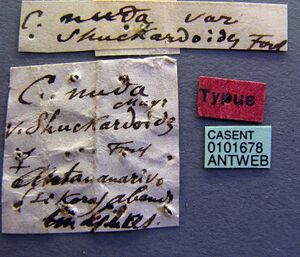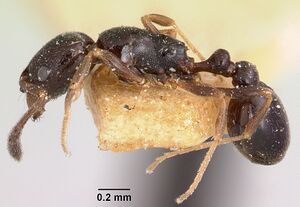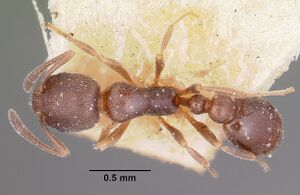Cardiocondyla shuckardi
| Cardiocondyla shuckardi | |
|---|---|

| |
| Scientific classification | |
| Kingdom: | Animalia |
| Phylum: | Arthropoda |
| Class: | Insecta |
| Order: | Hymenoptera |
| Family: | Formicidae |
| Subfamily: | Myrmicinae |
| Tribe: | Crematogastrini |
| Genus: | Cardiocondyla |
| Species: | C. shuckardi |
| Binomial name | |
| Cardiocondyla shuckardi Forel, 1891 | |
| Subspecies | |
| |
| Synonyms | |
| |
The most common and widespread endemic Cardiocondyla species in the Afrotropical region.
| At a Glance | • Facultatively polygynous • Ergatoid male |
Identification
Bolton (1982) - C. shuckardi is recognised by its dimensions and extremely reduced propodeal armament. Other species in the region with reduced propodeal armament include Cardiocondyla monardi, Cardiocondyla sekhemka and Cardiocondyla nilotica. In the first of these the metanotal groove is absent and the pedicel segments are very elongate. C. sekhemka is a much smaller species with shorter scapes and a broader head, and nilotica has longer scapes than shuckardi and a narrower postpetiole.
Seifert (2003) - A member of the Cardiocondyla shuckardi group. Cardiocondyla shuckardi is treated here as a polymorphic Malagasy and SE African species. The occurrence of transitions between the different sculpture and pubescence types observed in the type specimens of C. shuckardi and Cardiocondyla shuckardoides and the high overall similarity of these taxa suggest conspecifity.
Keys including this Species
Distribution
Latitudinal Distribution Pattern
Latitudinal Range: 25.45° to -34.326°.
| North Temperate |
North Subtropical |
Tropical | South Subtropical |
South Temperate |
- Source: AntMaps
Distribution based on Regional Taxon Lists
Afrotropical Region: Botswana, Cameroun, Gabon, Ghana, Kenya, Mozambique, Namibia, Nigeria, Rwanda, Saudi Arabia, South Africa, Uganda, United Arab Emirates, Zimbabwe, Zimbabwe, Zimbabwe.
Malagasy Region: Madagascar (type locality).
Palaearctic Region: Kuwait.
Distribution based on AntMaps
Distribution based on AntWeb specimens
Check data from AntWeb
Countries Occupied
| Number of countries occupied by this species based on AntWiki Regional Taxon Lists. In general, fewer countries occupied indicates a narrower range, while more countries indicates a more widespread species. |

|
Estimated Abundance
| Relative abundance based on number of AntMaps records per species (this species within the purple bar). Fewer records (to the left) indicates a less abundant/encountered species while more records (to the right) indicates more abundant/encountered species. |

|
Biology
|
Castes
Worker
Images from AntWeb
   
| |
| Syntype of Cardiocondyla shuckardi. Worker. Specimen code casent0101218. Photographer April Nobile, uploaded by California Academy of Sciences. | Owned by MHNG, Geneva, Switzerland. |
   
| |
| Syntype of Cardiocondyla shuckardi. Worker. Specimen code casent0101219. Photographer April Nobile, uploaded by California Academy of Sciences. | Owned by MHNG, Geneva, Switzerland. |
   
| |
| Syntype of Cardiocondyla shuckardi. Worker. Specimen code casent0101461. Photographer April Nobile, uploaded by California Academy of Sciences. | Owned by MNHN, Paris, France. |
   
| |
| Syntype of Cardiocondyla shuckardi. Worker. Specimen code casent0101678. Photographer April Nobile, uploaded by California Academy of Sciences. | Owned by MHNG, Geneva, Switzerland. |
   
| |
| Syntype of Cardiocondyla shuckardi. Worker. Specimen code casent0101859. Photographer Michele Esposito, uploaded by California Academy of Sciences. | Owned by MHNG, Geneva, Switzerland. |
   
| |
| Syntype of Cardiocondyla shuckardi. Worker. Specimen code casent0101891. Photographer April Nobile, uploaded by California Academy of Sciences. | Owned by MHNG, Geneva, Switzerland. |
Queen
Images from AntWeb
  
| |
| Specimen code casent0101127. . | |
Nomenclature
The following information is derived from Barry Bolton's Online Catalogue of the Ants of the World.
- shuckardi. Cardiocondyla shuckardi Forel, 1891b: 161 (w.) MADAGASCAR.
- Type-material: syntype workers (number not stated).
- Type-locality: Madagascar: Imerina, Antananarivo (P. Camboué).
- Type-depository: MHNG.
- Subspecies of nuda: Forel, 1895c: 251; Emery, 1922e: 126.
- Status as species: Dalla Torre, 1893: 71; Wheeler, W.M. 1922a: 1021; Santschi, 1932a: 387; Bolton, 1982: 316 (redescription); Collingwood, 1985: 257; Bolton, 1995b: 133; Collingwood & Agosti, 1996: 327; Rigato, 2002: 172 (in key); Seifert, 2003a: 257 (redescription); Collingwood, et al. 2011: 424; Borowiec, L. 2014: 48.
- Senior synonym of brevispinosa Weber: Bolton, 1982: 316; Bolton, 1995b: 133.
- Senior synonym of fusca: Bolton, 1982: 316; Bolton, 1995b: 133.
- Senior synonym of sculptior: Bolton, 1982: 316; Bolton, 1995b: 133.
- Senior synonym of shuckardoides: Seifert, 2003a: 257.
- Senior synonym of wassmanni: Bolton, 1982: 316; Bolton, 1995b: 133.
- Distribution
- Afrotropical: Botswana, Cameroon, Democratic Republic of Congo, Gabon, Ghana, Mozambique, Namibia, Nigeria, Saudi Arabia, South Africa, Uganda, Zimbabwe.
- Malagasy: Madagascar.
- Palaearctic: Iran, Kuwait, United Arab Emirates, Yemen.
- Current subspecies: nominal plus sculptinodis.
- brevispinosa. Cardiocondyla brevispinosa Weber, 1952a: 6 (w.) DEMOCRATIC REPUBLIC OF CONGO.
- Type-material: holotype worker.
- Type-locality: Democratic Republic of Congo (“Belgian Congo”): Beni, 0°24’N, 29°24’E, 24.ii.1948, no. 2116 (N.A. Weber).
- Type-depository: MCZC.
- [Unresolved junior secondary homonym of Pheidole brevispinosa Donisthorpe, 1948d: 593 (Bolton, 1982: 316).]
- Junior synonym of shuckardi: Bolton, 1982: 316; Bolton, 1995b: 132.
- fusca. Cardiocondyla fusca Weber, 1952a: 7 (w.) UGANDA.
- Type-material: holotype worker.
- Type-locality: Uganda: Jinja, edge of Ripon Falls, 15.viii.1939, no. 1495 (N.A. Weber).
- Type-depository: MCZC.
- Junior synonym of shuckardi: Bolton, 1982: 316; Bolton, 1995b: 132.
- sculptior. Cardiocondyla wasmanni var. sculptior Santschi, 1926b: 241 (w.) GABON.
- Type-material: holotype worker.
- Type-locality: Gabon: Samkita (F. Faure).
- Type-depository: NHMB (holotype lost, missing from mount (Bolton, 1982: 316)).
- As unavailable (infrasubspecific) name: Santschi, 1932a: 387.
- Junior synonym of shuckardi: Bolton, 1982: 316; Bolton, 1995b: 133.
- shuckardoides. Cardiocondyla nuda var. shuckardoides Forel, 1895c: 250 (w.) MADAGASCAR.
- Type-material: syntype workers (number not stated).
- Type-locality: Madagascar: Antananarivo (F. Sikora).
- Type-depository: MHNG.
- Subspecies of nuda: Wheeler, W.M. 1922a: 1021; Emery, 1922e: 126; Bolton, 1995b: 133.
- Junior synonym of shuckardi: Seifert, 2003a: 257.
- wasmanni. Cardiocondyla wassmanni Santschi, 1926b: 241 (w.) CAMEROON.
- [Justified emendation of spelling to wasmanni: Santschi, 1932a: 387.]
- Type-material: holotype worker.
- Type-locality: Cameroon: Gr. Batanga (G. Schwab) (received from Wasmann).
- Type-depository: NHMB.
- Subspecies of shuckardi: Santschi, 1932a: 387.
- Junior synonym of shuckardi: Bolton, 1982: 316; Bolton, 1995b: 133.
Unless otherwise noted the text for the remainder of this section is reported from the publication that includes the original description.
Description
Worker
Bolton (1982) - TL 2.0-2.6, HL 0.50-0.60, HW 0.38-0.46, CI 75-79, SL 0.36-0.45, SI 93-100, PW 0.27-0.35, AL 0.54-0.69 (35 measured).
Antennal scapes when laid back on the head in full-face view either just failing to reach or just reaching the occipital corners, never distinctly surpassing them; the scapes moderately long, SI > 90. Maximum diameter of eye 0.11-0.14, about 0.26-0.30 x HW and with 9-12 ommatidia in the longest row. Head always obviously longer than broad, CI < 80 in material examined. Pronotal corners in dorsal view broadly and evenly rounded. With the alitrunk in profile the promesonotal dorsum forming an even shallow convexity from front to back, sloping evenly into the metanotal groove. Metanotal groove impressed but the depth of the impression varying between samples. To some extent the apparent variation in depth is caused by the convexity of the propodeum behind the groove as in some cases it rises more steeply and is more convex than in others. Propodeal dorsum behind the convex portion sloping downwards posteriorly to the junction with the declivity. Propodeal armament very reduced, at best represented only by a pair of minute triangular denticles which may be acute or blunted, or by a pair of tubercles, or merely bluntly angular; never with developed teeth or spines. In dorsal view the propodeal armament scarcely visible, the length of each component constituting only a fraction of the distance separating their bases. Petiole node in dorsal view subglobular, usually broader than long but in some only about as broad as long. Postpetiole distinctly broader than long. In profile the petiole and postpetiole as in Fig. 1, the petiolar dorsum convex and somewhat variable in length. Sculpture of dorsal head and alitrunk usually of fine, very dense blanketing shagreening or granulation, but this may be reduced on tile alitrunk or even on the head, though less frequently on the latter than on the former. In extreme cases the dorsal alitrunk may be almost smooth. Hairs absent except on mouthparts and gastral apex. Colour varying from medium brown to blackish brown, sometimes black.
Type Material
Seifert (2003) - Syntype workers labelled by Forel “C. shuckardi Forel male, Imcrina Madagascar (Camboue)” and with a printed red label “Type”, Musee d'Histoire Naturelle Genève Geneve. 1 syntype worker labelled by Forel “C. shuckardi Forel d Type Antananarivo (Camboue)”, MHN Geneve.
References
- Seifert, B. 2003. The ant genus Cardiocondyla (Insecta: Hymenoptera: Formicidae) - a taxonomic revision of the C. elegans, C. bulgarica, C. batesii, C. nuda, C. shuckardi, C. stambuloffii, C. wroughtonii, C. emeryi, and C. minutior species groups. Annalen des Naturhistorischen Museums in Wien Serie B Botanik und Zoologie. 104:203-338. (page 257, Senior synonym of schuckardoides)
- Bolton, B. 1982. Afrotropical species of the myrmecine ant genera Cardiocondyla, Leptothorax, Melissotarsus, Messor and Cataulacus (Formicidae). Bulletin of the British Museum (Natural History). Entomology, 46: 307-370 (page 316, Senior synonym of brevispinosa, fusca, sculptior and wassmanni)
- Borowiec, L. 2014. Catalogue of ants of Europe, the Mediterranean Basin and adjacent regions (Hymenoptera: Formicidae). Genus (Wroclaw) 25(1-2): 1-340.
- Cantone S. 2018. Winged Ants, The queen. Dichotomous key to genera of winged female ants in the World. The Wings of Ants: morphological and systematic relationships (self-published).
- Collingwood, C.A., Agosti, D., Sharaf, M.R., van Harten, A. 2011. Order Hymenoptera, family Formicidae. Arthropod fauna of the UAE 4: 405-474.
- Forel, A. 1891c. Les Formicides. [part]. In: Grandidier, A. Histoire physique, naturelle, et politique de Madagascar. Volume XX. Histoire naturelle des Hyménoptères. Deuxième partie (28e fascicule). Paris: Hachette et Cie, v + 237 pp. (page 161, worker described)
- Forel, A. 1895d. Nouvelles fourmis de l'Imerina oriental (Moramanga etc.). Ann. Soc. Entomol. Belg. 39: 243-251 (page 251, Race of nuda)
- Heinze, J. 2019. Emeryia, Xenometra, zoserka: it's a boy, again! The misleading morphology of Cardiocondyla male ants. Insectes Sociaux 67, 139–146 (doi:10.1007/s00040-019-00737-5).
- Heinze, J., Schrempf, A., Wanke, T., Rakotondrazafy, H., Rakotondranaivo, T., Fisher, B. 2014. Polygyny, inbreeding, and wingless males in the Malagasy ant Cardiocondyla shuckardi Forel (Hymenoptera, Formicidae). Sociobiology 61: 300-306 (DOI 10.13102/sociobiology.v61i3.300-306).
- Jacobs, S. 2020. Population genetic and behavioral aspects of male mating monopolies in Cardiocondyla venustula (Ph.D. thesis).
- Nsengimana, V., Hagenimana, T., Barakagwira, J., de Dieu Nsenganeza, J., Iradukunda, S. C., Majyambere, M., Kizungu, O. B., Nkundimana, A., Umutoni, D., Fabrice, R., Cyubahiro, B., Kouakou, L. M., Kolo, Y., Anale, J. S., Gómez, K., Dekoninck, W. 2023. Checklist of ant (Hymenoptera: Formicidae) species from Nyungwe Tropical Rain Forest, south-western Rwanda. Journal of East African Natural History 111(2), 69-81 (doi:10.2982/028.111.0203).
- Satria, R. 2017. Taxonomy of the ant genus Odontomachus (Hymenoptera: Formicidae: Ponerinae) in the Indo-Chinese and Indo-Malayan subregions. Ph.D. thesis, Tokyo Metropolitan University.
- Seifert, B. 2022. The ant genus Cardiocondyla (Hymenoptera: Formicidae): The species groups with Oriental and Australasian origin. Diversity 15, 25 (doi:10.3390/d15010025).
- Seifert, B. 2023. A revision of the Palaearctic species of the ant genus Cardiocondyla Emery 1869 (Hymenoptera: Formicidae). Zootaxa 5274(1), 1–64 (doi:10.11646/zootaxa.5274.1.1).
- Sharaf, M.R., Al Dhafer, H.M., Abdel-Dayem, M.S., Aldawood, A.S. 2024. Cardiocondyla hashemi sp. n., a new species of the C. batesii species-group (Hymenoptera: Formicidae) from Saudi Arabia, with a key to the Saudi species. Zoology in the Middle East]] (doi:10.1080/09397140.2024.2321640).
- Wheeler, W. M. 1922k. Ants of the American Museum Congo expedition. A contribution to the myrmecology of Africa. IX. A synonymic list of the ants of the Malagasy region. Bull. Am. Mus. Nat. Hist. 4 45: 1005-1055 (page 1021, Revived status as species)
References based on Global Ant Biodiversity Informatics
- Addison P., and M. J. Samways. 2000. A survey of ants (Hymenoptera: Formicidae) that forage in vineyards in the Western Cape Province, South Africa
- Bolton B. 1982. Afrotropical species of the myrmicine ant genera Cardiocondyla, Leptothorax, Melissotarsus, Messor and Cataulacus (Formicidae). Bulletin of the British Museum (Natural History). Entomology 45: 307-370.
- Borowiec L. 2014. Catalogue of ants of Europe, the Mediterranean Basin and adjacent regions (Hymenoptera: Formicidae). Genus (Wroclaw) 25(1-2): 1-340.
- Collingwood C. A. 1985. Hymenoptera: Fam. Formicidae of Saudi Arabia. Fauna of Saudi Arabia 7: 230-302.
- Collingwood C. A., D. Agosti, M. R. Sharaf, A. Van Harten, 2011. Order Hymenoptera, family Formicidae. Arthropod Fauna of the UAE 4: 405-474
- Collingwood C.A., D.Agosti, M.R. Sharaf, and A. van Harten. 2011. Order Hymenoptera, family Formicidae. Arthropod fauna of the UAE, 4: 405474
- Collingwood, C. A., and Donat Agosti. "Formicidae (Insecta: Hymenoptera) of Saudi Arabia (Part 2)." Fauna of Saudi Arabia 15 (1996): 300-385.
- Collingwood, C. A.. "Hymenoptera: Fam. Formicidae of Saudi Arabia." Fauna of Saudi Arabia 7 (1985): 230-302.
- Fisher B. L. 1997. Biogeography and ecology of the ant fauna of Madagascar (Hymenoptera: Formicidae). Journal of Natural History 31: 269-302.
- Fisher B. L. 2003. Formicidae, ants. Pp. 811-819 in: Goodman, S. M.; Benstead, J. P. (eds.) 2003. The natural history of Madagascar. Chicago: University of Chicago Press, xxi + 1709 pp.
- Fisher B. L., H. G. Robertson. 2002. Comparison and origin of forest and grassland ant assemblages in the high plateau of Madagascar (Hymenoptera: Formicidae). Biotropica 34: 155-167.
- Ghosh S. N., S. Sheela, B. G. Kundu, S. Roychowdhury, and R. N. Tiwari. 2006. Insecta: Hymenoptera: Formicidae. Pp. 369-398 in: Alfred, J. R. B. (ed.) 2006. Fauna of Arunachal Pradesh. (Part -2). [State Fauna Series 13.]. New Delhi: Zoological Survey of India, iv + 518 pp.
- Heinze J., A. Schrempf, T. Wanke, H. Rakotondrazafy, T. Rakotondranaivo, and B. Fisher. 2014. Polygyny, inbreeding and wingless males in the Malagasy ant Cardiocondyla shuckardi Forel (Hymenoptera, Formicidae). Sociobiology 61(3): 300-305.
- IZIKO South Africa Museum Collection
- Kone M., S. Konate, K. Yeo, P. K. Kouassi, K. E. Linsemair. 2010. Diversity and abundance of terrrestrial ants along a gradient of land use intensification in a transitional forest-savannah zone of Cote d'Ivoire. Journal of Applied Biosciences 29: 1809-1827.
- Kone M., S. Konate, K. Yeo, P. K. Kouassi, and K. E. Linsenmair. 2012. Changes in ant communities along an age gradient of cocoa cultivation in the Oumé region, central Côte dIvoire. Entomological Science 15: 324339.
- Kouakou L. M. M., K. Yeo, K. Ouattara, W. Dekoninck, T. Delsinne, and S. Konate. 2018. Investigating urban ant community (Hymenoptera: Formicidae) in port cities and in major towns along the border in Côte d’Ivoire: a rapid assessment to detect potential introduced invasive ant species. Journal of Animal and Plant Sciences 36(1): 5793-5811.
- Kouakou L. M. M., W. Dekoninck, M. Kone, T. Delsinne, K. Yeo, K. Ouattara, and S. Konate. 2018. Diversity and distribution of introduced and potentially invasive ant species from the three main ecoregions of Côte d’Ivoire (West Africa). Belgian Journal of Zoology 148 (1): 83–103.
- Magagula C. N., and B. A. Nzimba. 2015. Interaction between habitat characteristics and insect diversity using ground beetles (Colenoptera: Carabidae) and ants (Hymenoptera: Formicidae) within a variety of agriculatural habitats. Applied Ecology and Environmental Research 13(3): 863-876.
- Samways M. J. 1990. Species temporal variability: epigaeic ant assemblages and management for abundance and scarcity. Oecologia 84: 482-490.
- Santschi F. 1926. Description de nouveaux Formicides éthiopiens (IIIme partie). Revue Zoologique Africaine (Brussels) 13: 207-267.
- Santschi F. 1932. Formicides sud-africains. Pp. 381-392 in: Jeannel, R. (ed.) 1932. Société Entomologique de France. Livre du centenaire. Paris: Société Entomologique de France, xii + 729 pp.
- Seifert B. 2003. The ant genus Cardiocondyla (Insecta: Hymenoptera: Formicidae) - a taxonomic revision of the C. elegans, C. bulgarica, C. batesii, C. nuda, C. shuckardi, C. stambuloffii, C. wroughtonii, C. emeryi, and C. minutior species groups. Annalen des Naturhistorischen Museums in Wien. B, Botanik, Zoologie 104: 203-338.
- Wheeler W. M. 1922. Ants of the American Museum Congo expedition. A contribution to the myrmecology of Africa. IX. A synonymic list of the ants of the Malagasy region. Bulletin of the American Museum of Natural History 45: 1005-1055

